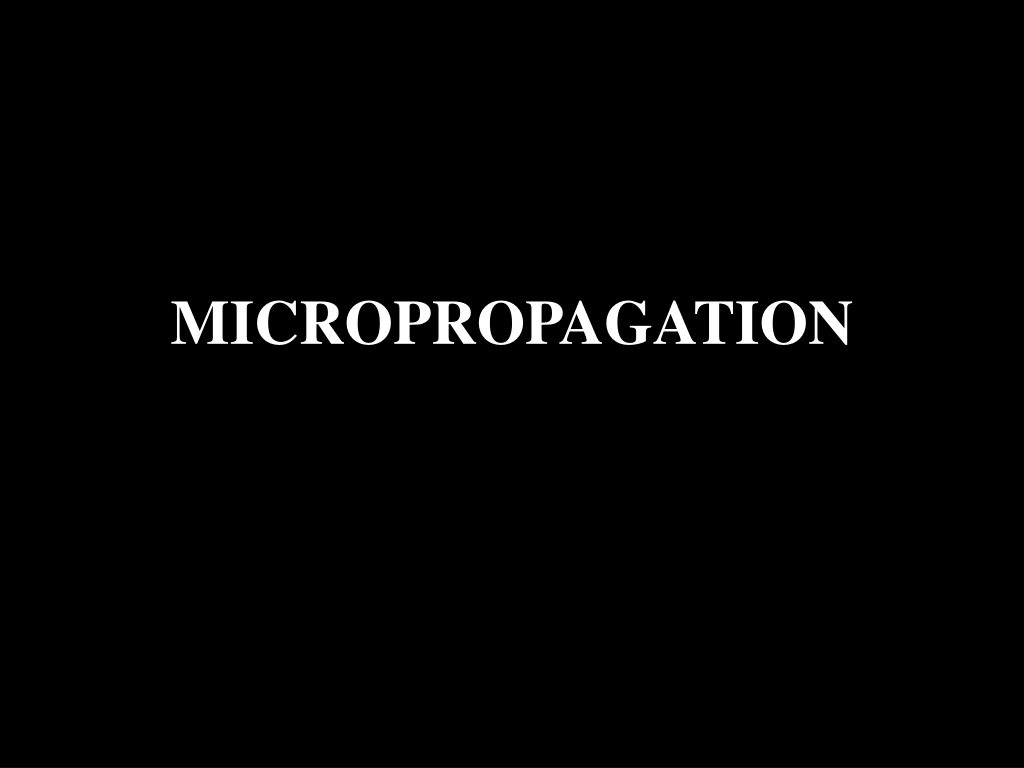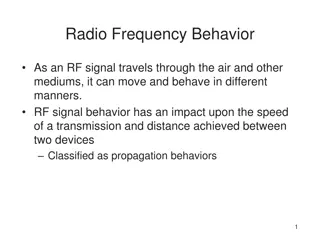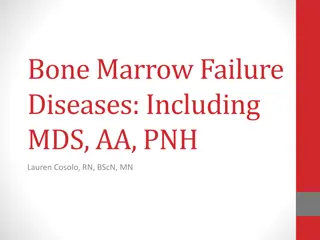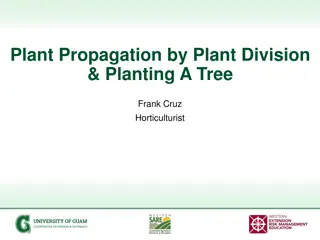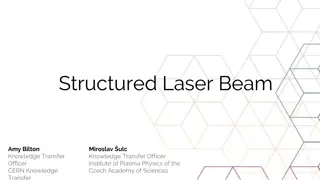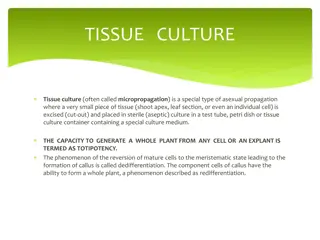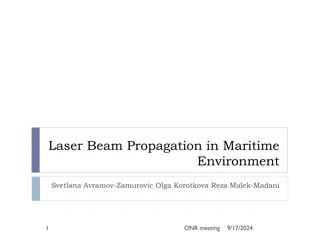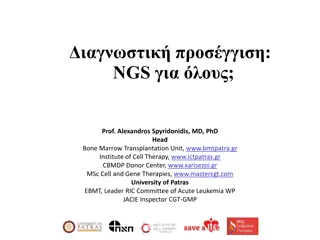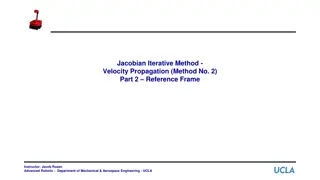Understanding Micropropagation: A Clonal Propagation Method
Micropropagation is a popular method for vegetative propagation in plants, providing genetically identical copies through aseptic tissue culture techniques. This technique allows for mass production of true-to-type plantlets in a short time, crucial for the commercial propagation of horticultural crops like orchids. Different explants, including shoot tips and lateral buds, are used in micropropagation to generate new plant growth. The process involves stages like preparative stage and quality control of mother plants to ensure successful propagation.
Download Presentation

Please find below an Image/Link to download the presentation.
The content on the website is provided AS IS for your information and personal use only. It may not be sold, licensed, or shared on other websites without obtaining consent from the author. Download presentation by click this link. If you encounter any issues during the download, it is possible that the publisher has removed the file from their server.
E N D
Presentation Transcript
INTRODUCTION Multiplication of genetically identical copies of a cultivar by asexual reproduction is called clonal propagation. In nature, clonal propagation occurs by apomixis (seed development withoutmeiosis and fertilization) and/or vegetative propagation (regeneration of new plants from vegetative parts).
Tissue culture has become popular method for vegetative propagation of plants. Aseptic method of clonal propagation is called as Micropropagation and it offer the advantage of large number of true-to-type plantlets can be produced with relatively short time and space from a single individual. It is the fact that micropropagation is the only commercially viable method of clonal propagation of most of the horticultural crops. E.g. Orchids
Explants used in micro propagation orchids, shoot tip (Anacamptis pyramidalis, Aranthera, Calanthe, Dendrobium), Axillary bud (Aranda, Brassocattleya, Cattleya, Laelia), inflorescence segment (Aranda, Ascofinetia,Neostylis, Vascostylisl
Lateral bud (Cattleya, Rhynocostylis gigantean), leaf base (Cattleya), leaf tip (Cattleya, Epidendrum), shoot tip (Cymbidium, Dendrobium, Odontioda, Odontonia), nodal segment (Dendrobium), flower stalk segment (Dendrobium, Phalaenopsis) and root tips(Neottia, Vanilla) are being used in micropropagation.
Differentiation of shoots directly from callus
Stages in micropropagation 5 Stages are there: Stage 0: Preparative stage 1. preparation of mother plants to provide quality explants for better establishment of aseptic cultures in stage 1. 2. To reduce the contamination problem in the subsequent stages, mother plant should be grown in a glasshouse and watered so as to avoid overhead irrigation
Stage 0: Preparative stage 3. Exposing the stock plants to suitable light, temperature and growth regulator treatments to improve the quality of explants
Stage 1. Initiation of culture 1. Explant: The nature of explant to be used for in vitro propagation is governed by the method of shoot multiplication. For enhanced axillary branching, only the explants which carry a pre-formed vegetative bud are suitable. When the objective is to produce virus-free plants from an infected individual it becomes necessary to start with sub-millimeter shoot tips.
Stage 1. Initiation of culture 2.Sterilization: Special precautions need to be taken when explants are derived from field grown materials, which is often necessary in cloning an elite tree. In such cases an ideal approach would be to take cuttings from the selected plant and grow them in greenhouse. Discarding the surface tissues from plant materials while preparing the explants also minimizes the loss of cultures due to microbial contamination
Stage 1. Initiation of culture 3. Browning of medium : A serious problem with the culture of some plant species is the oxidation of phenolic compounds leached out from the cut surface of the explant. It turns the medium dark brown and is often toxic to the tissues. This problem is common with the adult tissues from woody species.
Stage 2. Multiplication 3 approaches has been apoted: Through callusing: Differentiation of plants from cultured cells may occur via shoot- root formation (organogenesis) or somatic embryogenesis. A somatic embryogenesis system once established lends itself to better control than organogenesis.
Through callusing Somatic embryos being small, uniform and bipolar are more amenable to automation at the multiplication stage and for field planting as synthetic seeds, offering cost advantages from labour savings, can also be stored through cold storage, cryopreservation or desiccation for prolonged periods.
Through callusing These characteristics make somatic embryogenesis potentially a less expensive and flexible system for micropropagation. The most serious objection against the use of callus cultures for shoot multiplication is the genetic instability of their cells.
2. Adventitious bud formation: Buds arising from any place other than leaf axil or the shoot apex are termed adventitious buds. The shoots differentiated from calli should Buds arising from any place other than leaf axil or the shoot apex are termed adventitious buds. The shoots differentiated from calli should also be treated as adventitious buds.
2. Adventitious bud formation In many crops, vegetative propagation through adventitious bud formation from root (blackberry, raspberry) and leaf (Begonia, Crassula) cuttings isstandard horticultural practice For most bulbous plants (e.g. Lilley) adventitious bud formation is the most important mode of multiplication and the best explants are obtained from bulb scales
2. Adventitious bud formation A serious problem may arise when this method of propagation is applied to varieties which are genetic chimeras. Adventitious bud formation involves the risk of splitting the chimeras leading to pure type plants.
3. Enhanced axillary branching In cultures the rate of shoot multiplication by enhanced axillary branching can be substantially enhanced by growing shoots in a medium containing a suitable cytokinin at an appropriate concentration with or without auxin.
3. Enhanced axillary branching Due to continuous availability of cytokinin, the shoots formed by the bud, present on the explant, develops axillary buds which may grow directly into shoots. This process may be repeated several times and the initial explant transformed into a mass of branches.
Stage 3. Rooting of shoots Somatic embryos carry a pre-formed radical and may develop directly into plantlet. However, these embryos often show very poor conversion into plantlets, especially under in vitro conditions. They require an additional step of maturation to acquire the capability for normal germination.
Stage 3. Rooting of shoots Adventitious and axillary shoots developed in cultures in the presence of a cytokinin generally lack roots To obtain full plants the shoots must be transferred to a rooting medium which is different from the shoot multiplication medium, particularly in its hormonal and salt compositions
Stage 3. Rooting of shoots For rooting, individual shoots measuring 2 cm in length are excised and transferred to the rooting medium.
Stage 4. Transplantation The ultimate success of commercial propagation depends on the ability to transfer plants out of culture on a large scale, at low cost and with high survival rates.
Stage 4. Transplantation The plants multiplied in vitro are exposed to a unique set of growth conditions (high levels of inorganic and organic nutrients, growth regulators, sucrose as carbon source, high humidity, low light, poor gaseous exchange) which may support rapid growth and multiplication but also induce structural andphysiological abnormalities in the plants, rendering them unfit for survival under in vivo conditions.
Stage 4. Transplantation The two main deficiencies of in vitro grown plants are poor control of water loss and heterotrophic mode of nutrition. Therefore, gradual acclimatization is necessary for these plants to survive transition from culture to the greenhouse or field..
Stage 4. Transplantation During acclimatization the in vitro formed leaves do not recover but the plant develops normal leaves and functional roots. While transferring out shoots/roots their lower part is gently washed to remove the medium sticking to them.
Stage 4. Transplantation The individual shoots or plantlets are then transferred to potting mix and irrigated with low concentration of inorganic nutrients. This probably recommissions the photosynthetic machinery of plants, enabling them to withstand the subsequent reduction in the ambient relative humidity and survive under field conditions
Advantages of micropropagation 1. Clonal mass propagation:one can obtain more than 1,000,000 plants per year from one initial explant through micropropagation. 2. Culture is initialized from small parts of plants so no need of much space: from 1 m2 space in culture room, 20000 - 100000 plants can be produced per year.
Advantages of micropropagation 3. Production of disease and virus free plantlets. This leads to simplification of international exchange of plants 4. Micropropagation enables growers to increase the production of plants that normally propagate very slowly such as Narcissus and other bulbous crops.
Advantages of micropropagation 5. Introduction of disease free new cultivars is possible through micropropagation 6. Vegetative propagation of sterile hybrids can be used as parent plants for seed production. Eg. Cabbage 7. One of the rapid methods for cloning of disease free trees. 8. In vitro cultures can be stored for long time through cryopreservation.
Disadvantages of micropropagation 1. Expensive laboratory equipment and service 2. No possibility of using mechanization 3. Plants are not autotrophic 4. Poor Acclimatization to the field is a common problem (hyperhydricity) 5. Risk of genetic changes if 'de novo' regeneration is used .
Disadvantages of micropropagation 6. Mass propagation cannot be done with all crops to date. In cereals much less success is achieved 7. Regeneration is often not possible, especially with adult woody plant material. 8. More problems in inducing rooting
Disadvantages of micropropagation 9. May not get uniform growth of original plant from tissue culture. Each explant has different in vitro growth rates and maturation. Thus cannot be used for floriculture crop production where uniformity is critical.
Horticultural uses for plant tissue culture 1. Clonal mass propagation. The important point here is that extremely large numbers of plants can be produced. Rather than getting 10000 plants per year from an initial cutting, one can obtain upwards of 1,000,000 plants per year from one initial explant.
Horticultural uses for plant tissue culture 2. Difficult or slow to propagate plants. Micropropagation enables growers to increase the production of plants that normally propagate very slowly such as narcissus and other bulbous crops
Horticultural uses for plant tissue culture 3. Introduction of new cultivars eg. Dutch iris. Get 5 daughter bulbs annually. Takes 10 years for commercial quantities of new cultivars to be built up. Can get 100-1000 bulbs per stem section. 4. Vegetative propagation of sterile hybrids used as parent plants for seed production. Eg. cabbage.
Horticultural uses for plant tissue culture 5. Pathology - Eliminate viruses, bacteria, fungi etc. Use heat treatment and meristem culture. Used routinely for potatoes, carnation, mum, geranium, garlic, gypsophila 6. Storage of germplasm Generally the only successful method to date is keeping them in refrigerator. Slows down, but does not eliminate, alterations in genotype.
